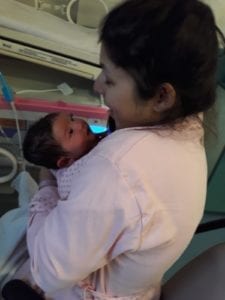Nursan Cinar
Hamide Zengin
Sakarya, Turkey

Two Hearts Beat at the Same Time
Photograph: Hamide Zengin
The rate of preterm birth is between 5 and 18% worldwide. Prematurity is the most important cause of neonatal mortality and morbidity, especially in developing countries. According to the World Health Organization (WHO), the neonatal mortality rate is 20% worldwide.1
Having a premature baby is a source of anxiety and stress for parents and family members and may lead to an acute emotional crisis.2,3 To have a baby with significant health problems in the Neonatal Intensive Care Unit (NICU), sometimes without being able to see and touch them, increases a parent’s fear and anxiety. A new parent may enter into a grieving process, feeling guilty and inadequate, which can lead to a lack of self-confidence, an inability to enter into parental roles, a delay in parent-infant attachment, and even non-acceptance of the baby. Parents may be anxious about touching their babies, fearing that they may harm them, and may avoid getting involved in their care.
“Kangaroo Care,” a method of caring for infants through skin-to-skin contact, was first used in Columbia by Edgar Rey Sanabria and Hector Martinez at the Bogotá Mother and Child Institute in 1978. The aim was to prevent infant deaths that were due to a lack of incubators. They also aimed to control costs and to decrease the risk of infection. Today this method is also used for premature and Low Birth Weight (LBW) babies who are cared for in incubators in developed nations, having become a part of standard care in countries around the world.4,5
Kangaroo Care (KC) allows interaction and skin-to-skin contact between an infant and a parent, family member, or healthcare professional.5-7 KC may be also be applied by caregivers or voluntary parents for babies who have lost or been abandoned by their parents. Thus, babies who have had an unlucky start to life can experience the benefits. It is also a great experience for nurses, allowing them to monitor and soothe their patient at the same time.
Skin-to-skin contact promotes relaxation and soothing, as the infant falls asleep to the heart sounds of the KC practitioner. During this practice, a mother keeps her baby inside her clothes to ensure the baby’s thermoregulation, and also to promote a sense of motherhood. KC helps to stabilize vital signs and shortens the length of hospital stay by decreasing the negative effects of the NICU on the baby. It allows the baby to breastfeed, which positively affects growth and development. KC has been shown to reduce infant mortality rates, provide physiological benefits, and is economical. The United Nations International Children’s Fund (UNICEF) began to support the practice in 1984.
We as pediatric nurses have all had moments when we thought we would lose a sick or premature infant. Once that infant is stronger, we have witnessed the joy, hope, and excitement of mothers who were finally able to hold their infants against their skin. We share tears and laughter with them, and they have told us: “It is great to feel our hearts beat together”; “It feels like it did when he was in my belly but now I can see him”; and “It is something I wanted to do before but could not.”
KC connects tiny hearts to life, raises parents’ hopes and connections to their premature or sick infant, and is also a unique occupational satisfaction for us, nurses who are able to combine science and medicine with a rewarding aesthetic experience.
References
- Howson C.P., Kinney M.V., Lawn J. March of Dimes, PMNCH, Save the Children, WHO; (2012). Born Too Soon: the global action report on preterm birth.; https://www.who.int/pmnch/knowledge/publications/preterm_birth_report/en/index3.html
- Ayvaz E, Acikgoz A. A Qualitative Study: Determination of the Opinions and Expectations of the Families with Infants Treated at the Newborn Intensive Care Unit, Osmangazi Journal of Medicine (2018).Doi: 10.20515/otd.426794.
- Arslan F, Turgut R. Prematüre bebeklerin evdeki bakım gereksinimleri ve bakım verme yeterliliklerini algılama durumları. Dokuz Eylül Üniversitesi Hemşirelik Fakültesi Dergisi (2013), 6(3): 119-124.
- Hardy W.Integration of kangaroo care into routine caregiving in the NICU: what is stopping you? Adv Neonatal Care. (2011) Apr, 11(2):119-21. doi: 10.1097/ANC.0b013e3182120b04.
- Ludington-Hoe SM. Kangaroo care as a neonatal therapy.Newborn InfantNurs Rev (2013);13:73-5.
- Carbasse, A., Kracher, S., Hausser, M., Langlet, C., Escande, B., Donato, L., & … Kuhn, P. Safety and effectiveness of skin-to-skin contact in the NICU to support neurodevelopment in vulnerable preterm infants. Journal of Perinatal & Neonatal Nursing, (2013),27(3), 255-262 8p. doi:10.1097/JPN.0b013e31829dc349
- Conde-Agudelo A, Díaz-Rossello JL. Kangaroo mother care to reduce morbidity and mortality in low birthweight infants. Cochrane Database of Systematic Reviews (2014), Issue 4. Art. No.: CD002771. DOI: 10.1002/14651858.CD002771.pub3.
NURSAN CINAR is a professor at Sakarya University School of Health Sciences. Her research focuses on pediatric nursing, health promotion, breastfeeding, nurse education, and environmental risk and health affect.
HAMIDE ZENGIN works as a nurse at Suluova State Hospital and at the same time, she is a doctoral student in the nursing program at the Institute of Health Sciences at the University of Sakarya. Her research interests include nursing, and maternal, newborn, and child health.

Leave a Reply